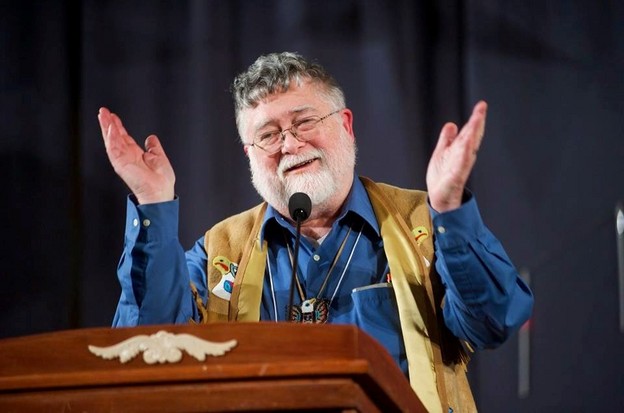Richard Dauenhauer: 22 Koyukon riddle-poems

Translated & arranged by Richard Dauenhauer after Father Julius Jetté, S.J.
[The riddle in verbal culture is part of the stock-in-trade of academic folklore, but its relation to the poetic image has rarely been explored until recently. The workings presented here were originally published in The Riddle and Poetry Handbook, developed by Richard Dauenhauer (1942-2014) as a project of the Alaska Native Education Board in Anchorage, Alaska. With Nora Dauenhauer, a native Tlingit speaker, Dauenhauer was engaged for many years in translation projects (Tlingit into English, English into Tlingit) aimed at Tlingit-speaking audiences.
In working with Father Julius Jetté’s 1913 notes Dauenhauer set the riddles up as two-part antiphonal texts, the initial image or utterance clarified or deepened by the utterance that followed.
Of the mind at work here, as well as its endangerment, Dauenhauer wrote further:
The riddles in Jetté exemplify the poetic use of everyday language and the imaginative juxtaposition of everyday images, of seeing something in terms of something else, and verbalizing that picture through manipulation of the wonderful and indefinite potential of language. With suppression and eradication of Native Alaskan intellectual traditions, and with the diminished possibilities of transmitting oral tradition because of language loss among the younger generations, a situation has developed in which even the average fluent speaker of Koyukon – through no fault of his or her own – is no longer familiar with riddles and riddle style.
The situation, since Dauenhauer wrote this in the late 1970s, may still be open to question. (J.R.)]
A selection of the riddle-poems, as first published by Dennis Tedlock and myself in Alcheringa and scheduled for publication in the expanded Technicians of the Sacred, follows.
****
Like a spruce tree
lying on the ground:
the back-hand
of the bear.
.
I drag my shovel
on the trail:
a beaver.
.
Water dripping
from an ice-spear tip:
water dripping
from the beaver's nose.
.
Like bones
piled up in the stream bed:
sticks
the beaver gnaws.
.
Flying upward,
ringing bells in silence:
the butterfly.
.
Muddy-light
dark-fresh
like two streams merging:
eagle feet.
.
At the tip it's
dipping in ashes:
ermine tail.
.
Faraway, a
fire flaring up:
red fox tail.
.
Small dots
on the skyline:
when the birds return.
.
As if the stream bed
were hacked up with a knife:
footprints of the swans
and geese.
.
Someone's throwing
sparks in the air: :
plucking the reddish feathers
of the grouse.
.
It scatters little wood crumbs
from the trees:
a roosting grouse, eating.
.
It looks like a flint:
the louse.
.
Round and shiny
at the end of my spruce bough:
Lynx feet
or the great gray owl.
.
It really snowed hard
in opposite directions
on my head:
a mountain sheep
.
At the water hole
the ice-spear
trembles in the current:
a swimming otter's tail.
.
Like forest branches
fluffing in the wind:
the great gray
owl ears.
.
Ptarmigan bills:
like bits of charcoal
scattered on the snow.
.
We come upstream
in red canoes:
the salmon.
.
Like a water plant:
floating salmon guts.
.
Smoke-like
it spreads out in the water:
butchered salmon blood.
.
The hilltop trail
running close beside me:
a thing on which
the wolf has peed.
Poems and poetics